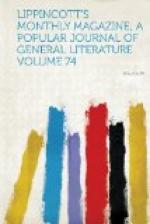“Again,” said he, turning down the gas, “if the flame be reduced to a consumption of two feet per hour, its light will be equal to that of one candle only; but on raising the chimney, thus, about half an inch from the gallery or support the light is greatly increased, or by simply placing a disk on top of the chimney the light is increased ninefold; both of which effects seem to result from a diminished current of air, while at the same time there is an ample supply. Lastly, with the ordinary glass moon-globe so generally used in dwellings with the fishtail burner little difference can be perceived between the light given from the flame by four feet and that from six feet of gas per hour, in consequence of the strong current of air passing up through the globe; but if the top of the glass be enclosed by a talc cover having an orifice in the centre about an inch in diameter, then the conditions of the burner are completely changed. The light is greatly increased, because the highest economical advantage is then approached."[2]
“Smoke from the aperture and lamp-black on the cover must result from such an arrangement,” objected the old gentleman.
“There need be very little of either,” responded the chemist. “From some burners there is little light without smoke. A smoky flame may arise from too much carbon, but the gas companies in this part of the country are not apt to make their product too rich; and such a condition is not likely to occur except with vapor-gas when warm weather quickly succeeds to a cold spell in the winter season. The consumer’s immediate remedy in any case is to use a smaller tip with the fishtail and batwing burners, and a taller chimney with the argand; which devices will give a quicker movement to the gas in one case and to the air in the other. The smoking, however, may be caused by carbonic acid, which checks combustion. There is always more or less of this in gas, arising from a partial combustion in the retorts when charging them with coal or while withdrawing the exhausted charge. But it is only by excessively slow and careless work that this can happen to a serious extent. Only an expert can tell when this condition exists, though if the symptoms do not yield to manipulations of the chimney and tap, it may be suspected. There is no effective remedy for this adulteration which can be applied by the consumer except a vigorous complaint against the company which supplies the stuff.
“There remains one burner or lamp to be mentioned, contrived with special reference to health,” he continued—“the ventilating standard lamp of Doctor Faraday, used in the House of Lords. In this there is an outer glass by which the vitiated air passes away through the pipe communicating with the external air. The lamp is interesting, but there is a question whether there is any practical advantage in its use. Rutter’s ventilating lamp is of different form, having a globe instead of an outer cylinder, the gas and air coming in from




